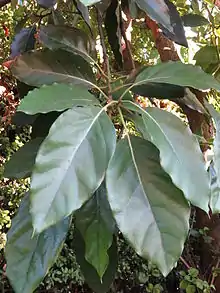Persin
Persin ist ein Acetogenin, ein Toxin aus der Gruppe der Polyketide, ein Fettsäurederivat, welches beispielsweise in den Blättern der Avocado (Persea americana) enthalten ist.[3] Der Trivialname leitet sich auch vom Gattungsnamen Persea der Avocado ab.
| Strukturformel | |||||||||||||
|---|---|---|---|---|---|---|---|---|---|---|---|---|---|
 | |||||||||||||
| Allgemeines | |||||||||||||
| Name | Persin | ||||||||||||
| Andere Namen |
(12Z,15Z)-2-Hydroxy-4-oxo-12,15-henicosadien-1-yl-acetat | ||||||||||||
| Summenformel | C23H40O4 | ||||||||||||
| Externe Identifikatoren/Datenbanken | |||||||||||||
| |||||||||||||
| Eigenschaften | |||||||||||||
| Molare Masse | 380,6 g·mol−1 | ||||||||||||
| Sicherheitshinweise | |||||||||||||
| |||||||||||||
| Soweit möglich und gebräuchlich, werden SI-Einheiten verwendet. Wenn nicht anders vermerkt, gelten die angegebenen Daten bei Standardbedingungen. | |||||||||||||
Es gilt als für den Menschen ungefährlich, während es für fast alle Haustiere (Pferde, Schafe, Ziegen, Kaninchen, Ziervögel, Strauße, Geflügel) und Fische giftig ist. Allgemeine Symptome einer Persinvergiftung sind Atemnot, Herzrasen, Zyanose, Ödeme, Erbrechen und Kolik.[4][5][6]

In der Humanmedizin wird es dagegen aufgrund einer brustzellspezifischen Wirkung in der Brustkrebsforschung intensiv untersucht.[7]
Bei Mäusen wurden nicht-tödliche Beschädigungen des Milchdrüsengewebes bei 60 bis 100 mg/kg und Nekrose von Herzmuskelgewebe mit 100 mg/kg Persin beschrieben.[8]
Die letale Dosis ist noch nicht bekannt, die Wirkung je nach Tierart verschieden. Für Mäuse wurden tödliche Dosen um 200 mg/kg Körpergewicht beschrieben.[8]
Einzelnachweise
- Shmuel Yannai: Dictionary of Food Compounds. Chapman & Hall, 2004, ISBN 1-58488-416-9, S. 324.
- Dieser Stoff wurde in Bezug auf seine Gefährlichkeit entweder noch nicht eingestuft oder eine verlässliche und zitierfähige Quelle hierzu wurde noch nicht gefunden.
- Tam Garland, A. Catherine Barr: Toxic Plants and Other Natural Toxicants. CABI, 1998, 1999, ISBN 0-85199-263-3, S. 86–89.
- Gerhard Habermehl und Petra Zimmer: Giftpflanzen und Intoxikationen. M.& H. Schaper, 2009, ISBN 978-3-7944-0208-3, S. 71, 172–173.
- Persea americana - Toxine auf vetpharm.uzh.ch, abgerufen am 20. November 2017.
- Persea americana - Veterinärtoxikologie auf vetpharm.uzh.ch, abgerufen am 28. Dezember 2017.
- C. G. Roberts, E. Gurisik, T. J. Biden, R. L. Sutherland, A. J. Butt: Synergistic cytotoxicity between tamoxifen and the plant toxin persin in human breast cancer cells is dependent on Bim expression and mediated by modulation of ceramide metabolism. In: Molecular Cancer Therapeutics. 6, Nr. 10, 2007, S. 2777–85. doi:10.1158/1535-7163.MCT-07-0374. PMID 17913853.
- P. B. Oelrichs, J. C. Ng, A. A. Seawright, A. Ward, L. Schäffeler, J. K. MacLeod: Isolation and identification of a compound from avocado (Persea americana) leaves which causes necrosis of the acinar epithelium of the lactating mammary gland and the myocardium. In: Nat. Toxins. 3, Nr. 5, 1995, S. 344–9. doi:10.1002/nt.2620030504. PMID 8581318. „non-fatal injury to the lactating mammary gland of the mouse is from 60 to 100 mg/kg. At doses of person above 100 mg/kg, necrosis of myocardial fibres may occur and areas of myocardial fibrosis can be observed in animals surviving for seven days. Hydrothorax and/or pulmonary oedema may be present in more severely affected animals. [..] there have been few attempts to investigate the cause of possible toxic effects of the plant in mammals.“
Literatur
- A. M. Hargis et al.: Avocado (Persea americana) intoxication in caged birds. In: J. Am. Vet. Med. Assoc. 194(1), 1989, 64–6, PMID 2914792.
- P. B. Oelrichs et al.: Isolation and identification of a compound from avocado (Persea americana) leaves which causes necrosis of the acinar epithelium of the lactating mammary gland and the myocardium. In: Nat. Toxins. 3(5), 1995, 344–9, PMID 8581318.
- K. H. Plumlee: Plant hazards. In: Vet. Clin. North Am. Small Anim. Pract. 32(2), 2002, 383–95, PMID 12012742.